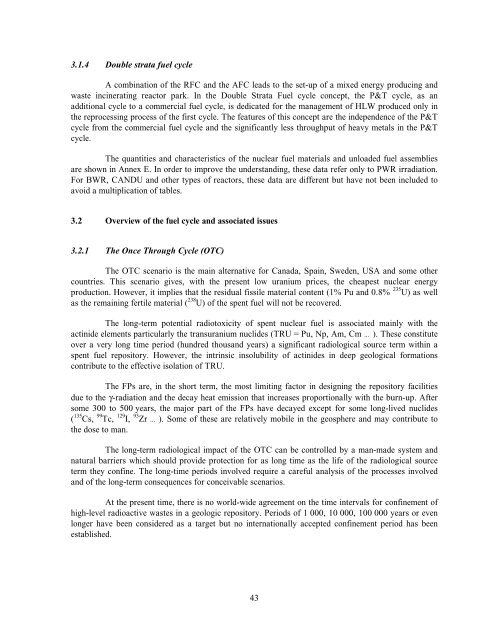COMPLETE DOCUMENT (1862 kb) - OECD Nuclear Energy Agency
COMPLETE DOCUMENT (1862 kb) - OECD Nuclear Energy Agency
COMPLETE DOCUMENT (1862 kb) - OECD Nuclear Energy Agency
You also want an ePaper? Increase the reach of your titles
YUMPU automatically turns print PDFs into web optimized ePapers that Google loves.
3.1.4 Double strata fuel cycle<br />
A combination of the RFC and the AFC leads to the set-up of a mixed energy producing and<br />
waste incinerating reactor park. In the Double Strata Fuel cycle concept, the P&T cycle, as an<br />
additional cycle to a commercial fuel cycle, is dedicated for the management of HLW produced only in<br />
the reprocessing process of the first cycle. The features of this concept are the independence of the P&T<br />
cycle from the commercial fuel cycle and the significantly less throughput of heavy metals in the P&T<br />
cycle.<br />
The quantities and characteristics of the nuclear fuel materials and unloaded fuel assemblies<br />
are shown in Annex E. In order to improve the understanding, these data refer only to PWR irradiation.<br />
For BWR, CANDU and other types of reactors, these data are different but have not been included to<br />
avoid a multiplication of tables.<br />
3.2 Overview of the fuel cycle and associated issues<br />
3.2.1 The Once Through Cycle (OTC)<br />
The OTC scenario is the main alternative for Canada, Spain, Sweden, USA and some other<br />
countries. This scenario gives, with the present low uranium prices, the cheapest nuclear energy<br />
production. However, it implies that the residual fissile material content (1% Pu and 0.8% 235 U) as well<br />
as the remaining fertile material ( 238 U) of the spent fuel will not be recovered.<br />
The long-term potential radiotoxicity of spent nuclear fuel is associated mainly with the<br />
actinide elements particularly the transuranium nuclides (TRU = Pu, Np, Am, Cm …). These constitute<br />
over a very long time period (hundred thousand years) a significant radiological source term within a<br />
spent fuel repository. However, the intrinsic insolubility of actinides in deep geological formations<br />
contribute to the effective isolation of TRU.<br />
The FPs are, in the short term, the most limiting factor in designing the repository facilities<br />
due to the γ-radiation and the decay heat emission that increases proportionally with the burn-up. After<br />
some 300 to 500 years, the major part of the FPs have decayed except for some long-lived nuclides<br />
( 135 Cs, 99 Tc, 129 I, 93 Zr …). Some of these are relatively mobile in the geosphere and may contribute to<br />
the dose to man.<br />
The long-term radiological impact of the OTC can be controlled by a man-made system and<br />
natural barriers which should provide protection for as long time as the life of the radiological source<br />
term they confine. The long-time periods involved require a careful analysis of the processes involved<br />
and of the long-term consequences for conceivable scenarios.<br />
At the present time, there is no world-wide agreement on the time intervals for confinement of<br />
high-level radioactive wastes in a geologic repository. Periods of 1 000, 10 000, 100 000 years or even<br />
longer have been considered as a target but no internationally accepted confinement period has been<br />
established.<br />
43
















